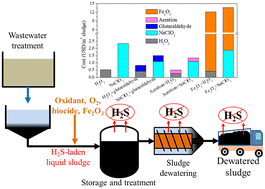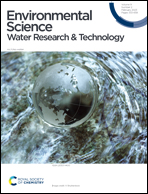Development of cost-effective and long-lasting integrated technology for H2S control from sludge in wastewater treatment plants†
Abstract
Hydrogen sulfide (H2S) production and emissions from sulfate-reducing bacteria (SRB) during wastewater and sludge (primary sludge and excess activated sludge) treatment and disposal are major concerns due to odor nuisance, corrosion, and health risks associated with H2S. The widely used chemical dosing approach requires high amounts of chemicals, resulting in high treatment costs. To develop cost-effective and long-lasting technologies for the H2S control from the sludge, this study proposed integrated methods, including oxidant–glutaraldehyde dosing, aeration–oxidant dosing, and oxidant–iron oxide (Fe2O3) dosing. Two oxidants (hydrogen peroxide and sodium chlorite) and one biocide (glutaraldehyde) were selected. All the integrated methods yielded good performances in the H2S control, from the sludge, due to the synergistic pathways involved, namely, sulfide oxidation by oxidants and Fe2O3, and the inhibition of the SRB activity by glutaraldehyde. The optimal removal efficiencies of H2S in the gas phase and dissolved sulfide in the sludge phase were up to 99.8% and 99%, respectively, within 4 h. Moreover, the integration of oxidants with glutaraldehyde and Fe2O3 decreased the hydrogen sulfide release by 66–93%, in prolonged periods of 24–48 h. The integrated oxidant–glutaraldehyde dosing and aeration–oxidant dosing, with treatment costs between 0.5–1.57 USD per m3 sludge, were more cost-effective than the integrated dosing of Fe2O3 (12.22–13.68 USD per m3 sludge), as well as the case of dosing a single oxidant (0.53–2.35 USD per m3 sludge). The findings demonstrated that the integrated oxidant–glutaraldehyde and aeration–oxidant dosing could be cost-effective and long-lasting alternatives to the conventional chemical dosings for H2S control from sludge, oil wells, and reservoirs. This shows the potential industrial application of this work.



 Please wait while we load your content...
Please wait while we load your content...